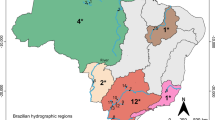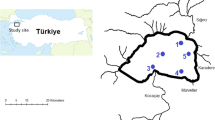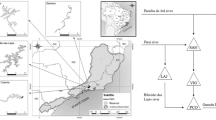Abstract
More heterogeneous environments allow for greater availability of ecological niches, thus favoring greater species diversity. However, it is not yet established how heterogeneity influences taxonomic and functional beta diversity. Therefore, we aimed to determine how environmental heterogeneity affects the patterns of taxonomic and functional beta diversity of planktonic microcrustaceans in reservoirs in different regions (semiarid and humid) in Northeast Brazil, in addition to verifying the influence of dry and rainy periods on these measures. Sampling from the semiarid region was carried out between 2013 and 2016, while samples from the humid region were collected between 2019 and 2021. Environmental heterogeneity and taxonomic and functional beta diversity were greater in the semiarid region, regardless of the hydrological period. However, regardless of the region, taxonomic beta diversity was greater during the dry period, while functional beta diversity did not differ between periods. Both types of diversity were driven mainly by local factors in the semiarid region, considered a region of high environmental heterogeneity due to the geomorphological and climatic characteristics that differentiate it from other regions. This type of study reinforces the need to conserve these reservoirs, especially those located in the semiarid region, as they support greater variability in species composition and functional traits.




Similar content being viewed by others
Data availability
This article contains complementary information with data from the list of available species, environmental variables and geographic location of the environments studied.
References
Agência Pernambuca de Águas e Clima – APAC, 2024. Bacias Hidrográficas de Pernambuco. Retrieved from https://www.apac.pe.gov.br/bacias-hidrograficas, accessed on February 5, 2024.
Alahuhta, J., et al., 2017. Global variation in the beta diversity of lake macrophytes is driven by environmental heterogeneity Rather than latitude. Journal of Biogeography 44: 1758–1769. https://doi.org/10.1111/jbi.12978.
Allan, J. D., 1976. Life history patterns in zooplankton. The American Society of Naturalists 110: 165–180. https://doi.org/10.1086/283056.
Anderson, M. J., K. E. Ellingsen & B. H. McArdle, 2006. Multivariate dispersion as a measure of beta diversity. Ecology Letters 9: 683–693. https://doi.org/10.1111/j.1461-0248.2006.00926.x.
Anderson, M. J. et al., 2011. Navigating the multiple meanings of β diversity: a roadmap for the practicing ecologista. Ecology Letters 14: 19–28. https://doi.org/10.1111/j.1461-0248.2010.01552.x.
Aspin, T. W. H., T. J. Matthews, K. Khamis, A. M. Milner, Z. Wang, M. J. O’Callaghan & M. E. Ledger, 2018. Drought intensification drives turnover of structure and function in stream invertebrate communities. Ecography 41: 1992–2004. https://doi.org/10.1111/ecog.03711.
Astorga, A., R. Death, F. Death, R. Paavola, M. Chakraborty & T. Muotka, 2014. Habitat heterogeneity drives the geographical distribution of beta diversity the case of New Zealand stream invertebrates. Ecology and Evolution 4: 2693–2702. https://doi.org/10.1002/ece3.1124.
Bakhtiyar, Y., M. Y. Arafat, S. Andrabi & H. I. Tak, 2020. Zooplankton: the significant ecosystem service provider in aquatic environment. Bioremediation and Biotechnology. 3: 227–244. https://doi.org/10.1007/978-3-030-46075-4_10.
Barbosa, J. E. L., E. S. F. Medeiros, J. Brasil, R. S. Cordeiro, M. C. B. Crispim & G. H. G. Silva, 2012. Aquatic systems in semi-arid Brazil: limnology and management. Acta Limnologica Brasiliensia 24: 103–118. https://doi.org/10.1590/S2179-975X2012005000030.
Barnett, A. J., K. Finlay & B. E. Beisner, 2007. Functional diversity of crustacean zooplankton communities: towards a trait-based classification. Freshwater Biology 52: 796–813. https://doi.org/10.1111/j.1365-2427.2007.01733.x.
Bonecker, C. C., F. A. Lansac-Tôha & D. C. Rossa, 1998. Planktonic and non-planktonic rotifers in two environments of the Upper Parana River floodplain, state of Mate Grosso do Sul, Brazil. Brazilian Archives of Biology and Technology 41: 447–456. https://doi.org/10.1590/S1516-89131998000400009.
Bottrell, H. H., A. Duncan, Z. M. Gliwicz, E. Grygierek, A. Herzzig, A. Hillbricht-Illkowska, H. Kurasawa, P. Larsson & T. Weglenska, 1976. A review of some problems in zooplankton production studies. Norwegian Journal of Zoology 24: 419–456.
Bozelli, R. L., S. M. Thomaz, A. A. Padial, P. M. Lopes & L. M. Bini, 2015. Floods decrease zooplankton beta diversity and environmental heterogeneity in an Amazonian floodplain system. Hydrobiologia 753: 233–241. https://doi.org/10.1007/s10750-015-2209-.
Braghin, L. S. M., B. A. Almeida, D. C. Amaral, T. F. Canella, B. C. G. Gimenez & C. C. Bonecker, 2018. Effects of dams decrease zooplankton functional β-diversity in river-associated lakes. Freshwater Biology 63: 721–730. https://doi.org/10.1111/fwb.13117.
Brasil, J., J. B. O. Santos, W. Souza, R. F. Menezes, V. L. M. Huszar & J. L. Attayde, 2019. Rainfall leads to habitat homogenization and facilitates plankton dispersal in tropical semi-arid lakes. Aquatic Ecology 54: 225–241. https://doi.org/10.1007/s10452-019-09738-9.
Brito, M. T. S., J. Heino, U. M. Pozzobom & V. L. Landeiro, 2020. Ecological uniqueness and species richness of zooplankton in subtropical floodplain lakes. Aquatic Sciences 82: 1–13. https://doi.org/10.1007/s00027-020-0715-3.
Brooks, J. L. & S. I. Dodson, 1965. Predation, body size, and composition of plankton. Science 150: 28–35. https://doi.org/10.1126/science.150.3692.28.
Cadotte, M. W., K. Carscadden & N. Mirotchnick, 2011. Beyond species: functional diversity and the maintenance of ecological processes and services. Journal of Applied Ecology 48: 1079–1087. https://doi.org/10.1111/j.1365-2664.2011.02048.x.
Cardoso, P., F. Rigal & J. C. Carvalho, 2015. BAT - biodiversity assessment tools, an R packge for the measurement and estimation of alpha and beta taxon, phylogenetic and diversity. Methods in Ecology and Evolution 6: 232–236. https://doi.org/10.1111/2041-210X.12310.
Carlos-Júnior, L. A., M. Spencer, D. M. Neves, T. P. Moulton, D. O. Pires, C. B. Castro, C. R. R. Ventura, C. E. L. Ferreira, C. S. Serejo, S. Oigman-Pszczol, F. A. Casares, M. C. Mantelatto & J. C. Creed, 2019. Rarity and beta diversity assessment as tools for guiding conservation strategies in marine tropical subtidal communities. Diversity and Distributions 25: 743–757. https://doi.org/10.1111/ddi.12896.
Cohen, G. M. & J. B. Shurin, 2003. Scale-dependence and mechanisms of dispersal in freshwater zooplankton. Oikos 103: 603–617. https://doi.org/10.1034/j.1600-0706.2003.12660.x.
Crabot, J., J. Heino, B. Launay & T. Datry, 2019. Drying determines the temporal dynamics of stream invertebrate structural and functional beta diversity. Ecography 42: 1–16. https://doi.org/10.1111/ecog.04835.
Da Silva, N. J., F. M. Lansac-Tôha, F. A. Lansac-Tôha, P. C. L. Sales & J. R. S. Rocha, 2021. Beta diversity patterns in zooplankton assemblages from a semiarid river ecosystem. International Review of Hydobiology 106: 29–40. https://doi.org/10.1002/iroh.201902018.
Datry, T., N. Bonada & J. Heino, 2016. Towards understanding the organisation of metacommunities in highly dynamic ecological systems. Oikos 125: 149–159. https://doi.org/10.1111/oik.02922.
Dias, J. D., N. R. Simões, M. Meerhoff, F. A. Lansac-Tôha, L. F. M. Velho & C. C. Bonecker, 2016. Hydrological dynamics drives zooplankton metacommunity structure in a Neotropical floodplain. Hydrobiologia 781: 109–125. https://doi.org/10.1007/s10750-016-2827-2.
Diniz, L. P., L. S. M. Braghin, T. S. A. Pinheiro, P. A. M. C. Melo, C. C. Bonecker & M. Melo Júnior, 2021. Environmental filter drives the taxonomic and functional β-diversity of zooplankton in tropical shallow lakes. Hydrobiologia 848: 1881–1895. https://doi.org/10.1007/s10750-021-04562-5.
Duré, G. A. V., N. R. Simões, L. S. M. Braghin & S. M. M. S. Ribeiro, 2021. Effect of eutrophication on the functional diversity of zooplanktonin shallow ponds in Northeast Brazil. Journal of Plankton Research 43: 894–907. https://doi.org/10.1093/plankt/fbab064.
Eissa, A. E. & M. M. Zaki, 2011. The impact of global climatic changes on the aquatic environment. Procedia Environmental Sciences 4: 251–259. https://doi.org/10.1016/j.proenv.2011.03.030.
Elmoor-Loureiro, L. M. A., 1997. Manual de identificação de cladóceros límnicos do Brasil. Brasília.
Epele, L. B., C. Brand & M. L. Miserendino, 2019. Ecological drivers of alpha and beta diversity of freshwater invertebrates in arid and semiarid Patagonia (Argentina). Science of the Total Environment 678: 62–73. https://doi.org/10.1016/j.scitotenv.2019.04.392.
Freiry, R. F., V. Weber, C. C. Bonecker, F. A. Lansac-Tôha, M. M. Pires, C. Stenert & L. Maltchik, 2020. Additive partitioning of the diversity of the dormant zooplankton communities in intermittent ponds along a forest–grassland transition. Hydrobiologia 847: 1327–1342. https://doi.org/10.1007/s10750-020-04187-0.
Gower, J. C., 1971. A general coefficient of similarity and some of its properties. Biometrics 27: 857–871. https://doi.org/10.2307/2528823.
Güntzel, A. M., E. A. Panarelli, W. M. Silva & K. F. Roche, 2010. Influence of connectivity on Cladocera diversity in oxbow lakes in the Taquari River floodplain (MS, Brazil). Acta Limnologica Brasiliensia 22: 93–101. https://doi.org/10.4322/actalb.02201012.
Gutierrez, M. F., L. B. Epele, G. Mayora, D. Aquino, C. Moura, R. Quintana & L. Mesa, 2022. Hydro-climatic changes promote shifts in zooplankton composition and diversity in wetlands of the Lower Paraná River Delta. Hydrobiologia 849: 3463–3480. https://doi.org/10.1007/s10750-022-04955-0.
Habibullah, M. S., B. H. Din, S.-H. Tan & H. Zahid, 2021. Impact of climate change on biodiversity loss: global evidence. Environmental Science and Pollution Research 29: 1073–1086. https://doi.org/10.1007/s11356-021-15702-8.
Havel, J. E. & J. B. Shurin, 2004. Mechanisms, effects, and scales of dispersal in freshwater zooplankton. Limnology and Oceanography 49: 1229–1238. https://doi.org/10.4319/lo.2004.49.4_part_2.1229.
Hawkins, C. P., H. Mykra, J. Oksanen & J. J. V. Lann, 2014. Environmental disturbance can increase beta diversity of stream macroinvertebrate assemblages. Global Ecology and Biogeography 24: 483–494. https://doi.org/10.1111/geb.12254.
Heino, J., M. Gronroos, J. Ilmonen, T. Karhu, M. Niva & L. Paasivirta, 2013. Environmental heterogeneity and β diversity of stream macroinvertebrate communities at intermediate spatial scales. Freshwater Science 32: 142–154. https://doi.org/10.1899/12-083.1.
Heino, J. A. S., T. Melo, J. Siqueira, S. Valanko. Soininen & L. M. Bini, 2014. Metacommunity organisation, spatial extent and dispersal in aquatic systems: patterns, processes and prospects. Freshwater Biology 60: 845–1068. https://doi.org/10.1111/fwb.12533.
Heino, J., J. Alahuhta, S. Fattorini & D. Schmera, 2018. Predicting beta diversity of terrestrial and aquatic beetles using ecogeographical variables: insights from the replacement and richness difference components. Journal of Biogeography 46: 304–315. https://doi.org/10.1111/jbi.13485.
Instituto Brasileiro de Geografia e Estatística - IBGE, 2023. Biomas Continentais do Brasil. Retrieved from https://ibge.gov.br, accessed on May 5, 2023.
Kiørboe, T., 2011. How zooplankton feed: mechanisms, traits and trade-offs. Biol Rev 86: 311–339. https://doi.org/10.1111/j.1469-185X.2010.00148.x
Laliberté, E., P. Legendre, B. Shipley & M. E. Laliberté, 2014. Package ‘FD’. Measuring Functional Diversity from Multiple Traits, and Other Tools for Functional Ecology. R package version 1.0–12. https://cran.r-project.org/web/packages/FD/index.html
Langenheder, S. & H. Ragnarsson, 2007. The role of environmental and spatial factors for the composition of aquatic bacterial communities. Ecology 88: 2154–2161. https://doi.org/10.1890/06-2098.1.
Leão-Pires, T. A., A. M. Luiz & R. J. Sawaya, 2018. The complex roles of space and environment in structuring functional, taxonomic and phylogenetic beta diversity of frogs in the Atlantic Forest. PLOS ONE 13: e0196066. https://doi.org/10.1371/journal.pone.0196066.
Litchman, E., M. D. Ohman & T. Kiørboe, 2013. Trait-based approaches to zooplankton communities. Journal of Plankton Research 35: 473–484. https://doi.org/10.1093/plankt/fbt019.
Liu, J., M. Vellend, Z. Wang & M. Yu, 2018. High beta diversity among small islands is due to environmental heterogeneity rather than ecological drift. Journal of Biogeography 45: 2252–2261. https://doi.org/10.1111/jbi.13404.
Lopes, P. M., L. M. Bini, S. A. J. Declerck, V. F. Farjalla, L. C. G. Vieira, C. C. Bonecker, F. A. Lansac-Toha, F. A. Esteves & R. L. Bozelli, 2014. Correlates of Zooplankton Beta Diversity in Tropical Lake Systems. PLOS ONE 9: e109581. https://doi.org/10.1371/journal.pone.0109581.
Maechler, M., P. Rousseeuw, A. Struyf, M. Hubert & K. Hornik, 2019. cluster: Cluster Analysis Basics and Extensions. R package version 2.1.0. https://cran.r-project.org/web/packages/cluster/index.html
Magurran, A. E., 2004. Measuring Biological Diversity, Blackwell Publishing, Oxford:
Maloufi, S., A. Catherine, D. Mouillot, C. Louvard, A. Couté, C. Bernard & M. Troussellier, 2016. Environmental heterogeneity among lakes promotes hyper β-diversity across phytoplankton communities. Freshwater Biology 61: 633–645. https://doi.org/10.1111/fwb.12731.
Maltchik, L. & E. S. F. Medeiros, 2006. Conservation importance of semiarid streams in north-eastern Brazil: implications of hydrological disturbance and species diversity. Aquatic Conservation: Marine and Freshwater Ecosystems 16: 65–677. https://doi.org/10.1002/aqc.805.
Matsumura-Tundisi, T., 1986. Latitudinal distribution of Calanoida copepods in freshwater aquatic systems of Brazil. Brazilian Journal of Biology 46: 527–553.
Morellato, L. P. C., 2000. Introduction: The Brazilian Atlantic Forest. Biotropica 4: 786–792. https://doi.org/10.1111/j.1744-7429.2000.tb00618.x.
Mouillot, D., N. A. J. Graham, S. Villéger, N. W. H. Mason & D. R. Bellwood, 2012. A functional approach reveals community responses to disturbances. Trends in Ecology & Evolution 28: 167–177. https://doi.org/10.1016/j.tree.2012.10.004.
Ohman, M. D., 1988. Behavioral responses of zooplankton to predation. Bulletin of Marine Science 43: 530–550.
Oksanen, J., F. G. Blanchet, M. Friendly, R. Kindt, P. Legendre, D. McGlinn, P. Minchin, R. B. O’Hara, G. L. Simpson, P. Solymos, M. H. H. Stevens, E. Szoecs & E. Wagner, 2018. vegan: Community Ecology Package. R package version 2.5–3. https://CRAN.R-project.org/package=vegan.
Peláez, O. & C. S. Pavanelli, 2018. Environmental heterogeneity and dispersal limitation explain different aspects of β-diversity in Neotropical fish assemblages. Freshwater Biology 64: 497–505. https://doi.org/10.1111/fwb.13237.
Pennington, R. T., M. Lavin & A. Oliveira-Filho, 2009. Woody plant diversity, evolution, and ecology in the tropics: perspectives from seasonally dry tropical forests. Annual Review of Ecology, Evolution, and Systematics 40: 437–457. https://doi.org/10.1146/annurev.ecolsys.110308.120327.
Perbiche-Neves, G., G. A. Boxshall, D. Previattelli, M. G. Nogueira & C. E. F. Rocha, 2015. Identification guide to some Diaptomid species (Crustacea, Copepoda, Calanoida, Diaptomidae) of ‘“de la Plata”’ River Basin (South America). ZooKeys 497: 1–111. https://doi.org/10.3897/zookeys.497.8091.
Pozzobom, U. M., V. L. Landeiro, M. T. S. Brito, J. Alahuhta & J. Heino, 2021. Multiple facets of macrophyte beta diversity are shaped by environmental factors, directional spatial processes, and connectivity across tropical floodplain lakes in the dry season. Hydrobiologia 848: 3587–3602. https://doi.org/10.1007/s10750-021-04613-x.
Ramos, E. A., A. T. R. Okumura, A. G. Silva, T. L. Pereira & N. R. Simões, 2021. Alpha and beta diversity of planktonic microcrustaceans are associated with environmental heterogeneity in the Frades River Basin, Brazil. Studies on Neotropical Fauna and Environment 58: 226–237. https://doi.org/10.1080/01650521.2021.1933702.
R Core Team, 2018. R: A Language and Environment for Statistical Computing. R Foundation for Statistical Computing, Vienna
Reid, J. W., 1985. Chave de identificação e lista de referências bibliográficas para espécies continentais sul-americanas de vida livre da ordem Cyclopoida (Crustacea, Copepoda). Boletim De Zoologia 9: 17–143. https://doi.org/10.11606/issn.2526-3358.bolzoo.1985.122293.
Reid, W. V., 1998. Biodiversity hotspots. Trends in Ecology & Evolution 13: 275–280. https://doi.org/10.1016/S0169-5347(98)01363-9.
Reynolds, C. S., 2006. The Ecology of Phytoplankton. Cambridge University Press, Cambridge.
Ribeiro, M.C., A. C. Martensen, J. P. Metzger, M. Tabarelli, F. Scarano & M-J. Fortin, 2011. The Brazilian Atlantic Forest: A Shrinking Biodiversity Hotspot. In: Zachos, F., Habel, J. (eds) Biodiversity Hotspots. Springer, Berlin, Heidelberg, cap. 21, 405–434. https://doi.org/10.1007/978-3-642-20992-5_21
Rocha, O., S. Sendacz & T. Matsumura-Tundisi, 1995. Composition, biomass and productivity of zooplankton in natural lakes and reservoirs in Brazil, p. 151-166. In: Tundisi, J. G., C. E. M. Bicudo & T. Matsumura-Tundisi (eds.), Limnology in Brazil. ABC/SBL, Rio de Janeiro.
Rocha Junior, C. A. N. et al., 2018. Water volume reduction increases eutrophication risk in tropical semi-arid reservoirs. Acta Limnologica Brasiliensia 30: e106. https://doi.org/10.1590/S2179-975X2117
Ruhí, A., T. Datry & J. L. Sabo, 2017. Interpreting beta-diversity components over time to conserve metacommunities in highly dynamic ecosystems. Conservation Biology 31: 1459–1468. https://doi.org/10.1111/cobi.12906.
Santos, J. B. O., L. H. S. Silva, C. W. C. Branco & V. L. M. Huszar, 2016. The roles of environmental conditions and geographical distances on the species turnover of the whole phytoplankton and zooplankton communities and their subsets in tropical reservoirs. Hydrobiologia 764: 171–186. https://doi.org/10.1007/s10750-015-2296-z.
Simões, N. R., L. S. M. Braghin, G. A. V. Duré, J. S. Santos, S. L. Sonoda & C. C. Bonecker, 2020. Changing taxonomic and functional b-diversity of cladoceran communities in Northeastern and South Brazil. Hydrobiologia 847: 3845–3856. https://doi.org/10.1007/s10750-020-04234-w.
Socolar, J. B., J. J. Gilroy, W. E. Kunin & D. P. Edwards, 2015. How should beta-diversity inform biodiversity conservation? Trends in Ecology & Evolution 31: 67–80. https://doi.org/10.1016/j.tree.2015.11.005.
Sodré, E. O. & R. L. Bozelli, 2019. How planktonic microcrustaceans respond to environment and affect ecosystem: a functional trait perspective. International Aquatic Research 11: 207–223. https://doi.org/10.1007/s40071-019-0233-x
Stein, A., K. Gerstner & H. Kreft, 2014. Environmental heterogeneity as a universal driver of species richness across taxa, biomes and spatial scales. Ecology Letters 17: 771–890. https://doi.org/10.1111/ele.12277.
Strayer, D. L. & D. Dudgeon, 2010. Freshwater biodiversity conservation: recent progress and future challenges. Society for Freshwater Science 29: 344–358. https://doi.org/10.1899/08-171.1.
Stubbington, R., R. Sarremejane & T. Datry, 2019. Alpha and beta diversity of connected benthic–subsurface invertebrate communities respond to drying in dynamic river ecosystems. Ecography 42: 2060–2073. https://doi.org/10.1111/ecog.04592.
Tews, J., U. Brose, V. Grimm, K. Tielbörger, M. C. Wichmann, M. Schwager & F. Jeltsch, 2004. Animal species diversity driven by habitat heterogeneity/diversity: the importance of keystone structures. Journal of Biogeography 31: 79–92. https://doi.org/10.1046/j.0305-0270.2003.00994.x.
Vinebrooke, R. D., K. L. Cottingham, J. Norberg, M. Scheffer, S. I. Dodson, S. C. Maberly & U. Sommer, 2004. Impacts of multiple stressors on biodiversity and ecosystem functioning: the role of species co-tolerance. Oikos 104: 451–457. https://doi.org/10.1111/j.0030-1299.2004.13255.x.
Walsh, M. R., 2013. The link between environmental variation and evolutionary shifts in dormancy in zooplankton. Integrative and Comparative Biology 53: 713–722. https://doi.org/10.1093/icb/ict035.
Wickham, H., 2016. ggplot2: Elegant graphics for data analysis, Springer-Verlag, New York:
Woodward, G., 2009. Biodiversity, ecosystem functioning and food webs in fresh waters: Assembling the jigsaw puzzle. Freshwater Biology 54: 2171–2187. https://doi.org/10.1111/j.1365-2427.2008.02081.x.
Zhang, Y., L. Cheng, K. Li, L. Zhang, Y. Cai, X. Wang & J. Heino, 2018. Nutrient enrichment homogenizes taxonomic and functional diversity of benthic macroinvertebrate assemblages in shallow lakes. Limnology and Oceanography 64: 1047–1058. https://doi.org/10.1002/lno.11096.
Zorzal-Almeida, S., L. M. Bini & D. C. Bicudo, 2017. Beta diversity of diatoms is driven by environmental heterogeneity, spatial extent and productivity. Hydrobiologia 800: 7–16. https://doi.org/10.1007/s10750-017-3117-3.
Acknowledgements
We thank the Coordination for the Improvement of Higher Education Personnel (CAPES) for granting a doctoral scholarship to the first author (Process 88887.649431/2021-00). The authors also thank the Plankton Ecology Laboratory (Leplanc), as well as the Postgraduate Program in Biodiversity (PPGBio) and the Federal Rural University of Pernambuco (UFRPE) for logistical support.
Author information
Authors and Affiliations
Corresponding author
Additional information
Handling editor: María Florencia Gutierrez.
Publisher's Note
Springer Nature remains neutral with regard to jurisdictional claims in published maps and institutional affiliations.
Supplementary Information
Below is the link to the electronic supplementary material.
Rights and permissions
Springer Nature or its licensor (e.g. a society or other partner) holds exclusive rights to this article under a publishing agreement with the author(s) or other rightsholder(s); author self-archiving of the accepted manuscript version of this article is solely governed by the terms of such publishing agreement and applicable law.
About this article
Cite this article
Aguiar, J.L., Diniz, L.P. & Melo Júnior, M. Dryland reservoirs support greater taxonomic and functional beta diversity of zooplankton regardless of hydrological period. Hydrobiologia (2024). https://doi.org/10.1007/s10750-024-05558-7
Received:
Revised:
Accepted:
Published:
DOI: https://doi.org/10.1007/s10750-024-05558-7




